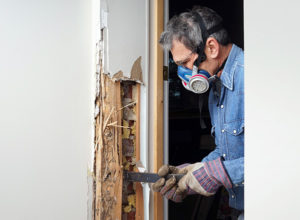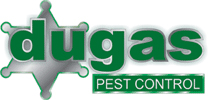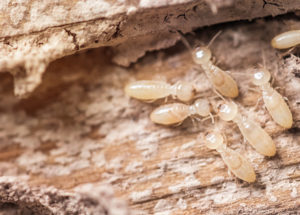 Termites are a big threat to wooden structures of all types and in particular, to homes. It is estimated that every year, termites cause around 40 billion dollars of damage to homes and other buildings worldwide besides damaging around 600,000 homes just in the United States.
Termites are a big threat to wooden structures of all types and in particular, to homes. It is estimated that every year, termites cause around 40 billion dollars of damage to homes and other buildings worldwide besides damaging around 600,000 homes just in the United States.
With the growing concern over various environmental issues like pollution, many people are looking for new methods of repelling termites.
In this article, we will take a look at different types of termites, why they might prefer one home over another, and which materials you use around your home may prevent them from damaging it.
General causes of termite infestation
There are a couple of major predictors of termite activity and a few things that appeal to particular species as well:
First of all, termites are very attracted to moisture, and they will gravitate to areas of your house that are moist and dark, like basements, laundry rooms, bathrooms, and areas with leaky piping.
Termites eat wood of almost all kinds, but specific species like certain types of wood better than others. If your house is surrounded by untreated foliage, this can be a way that termites are introduced to your walls and home in general.
Going along with the moist concept from earlier, termites also prefer that the air is stagnant and moist. Circulating your air can do a lot to prevent an infestation, especially in areas that attract moisture, like rooms with potted plants or pools of standing water.
If you are renovating your house, make sure to keep any new lumber in a place where it won’t be infested, and make sure to burn old lumber that had termites to prevent them from spreading to the new addition or remodeled section.
Finally, avoid putting mulch or dirt near the foundation of your house because this is an easy way for termites to get into your home.
Termites Resistant Wood
The type of wood that termites like to eat depends on the species of termite in the region of the world that you are in, but there are some general similarities between all of them.
Scientists have been experimenting with what they call allelochemicals, which are substances found in the heartwood of some trees that naturally repel insects, or in some cases, even kill them. Several of the trees they tested, such as Brazilian jabota, Peruvian walnut, Honduran mahogany, and a few others showed much higher than average resistance to the termites forced to eat them.
In particular, the group of termites that were fed teak actually exhibited a higher mortality rate than the control group which they didn’t feed anything to at all. This suggests that not only does teak resist termite infestation, something in the wood actively kills them.
Although we can’t make every house out of teak, it is only so long before a preventative measure is developed using what these scientists have learned.
Preventative steps
For now, however, there are a couple preventative steps you can take on your own. We have covered a few of these already in the previous section above, such as ventilating stagnant rooms and trimming brush away from the sides of buildings.
You can also cover the soil in crawl spaces with plastic sheeting and remove as much wood to soil contact as possible.
Additionally, do not put two pieces of wood together in a way that creates a dark, wooden space that termites can infest – so, don’t stack loose wood next to a wooden wall or affix a wooden trellis to wooden siding.
Other prevention measures are just basic home maintenance, such as clearing leaves out of gutters and removing infested trees and stumps from the property.
Finally, seal up cracks in order to prevent termites from finding their way inside.
One day, we might have a natural and completely environmentally friendly way to prevent termite infestations. Until that time, however, there are plenty of old methods that make a lot of sense and are fairly effective.
Keep these tips in mind to help prevent your house from being the neighborhood termite’s target. If you do find termites near your home, however, you must call a professional like the ones at Dugas in order to avoid damaging your home further and to make sure that all the termites are gone. We offer a free consultation, so there is no reason to delay!

 The termite problem is serious and it is not going away anytime soon. As springtime gets into full swing, it tends to bring people out of their homes so they can enjoy the warm air. Of course, the warmer weather also means that the
The termite problem is serious and it is not going away anytime soon. As springtime gets into full swing, it tends to bring people out of their homes so they can enjoy the warm air. Of course, the warmer weather also means that the  Termites are more common than you may realize, although they are not easily detected. That’s why it’s vital for homeowners to get termite inspections from a reputable professional. An inspection will ensure that your home remains termite-free.
Termites are more common than you may realize, although they are not easily detected. That’s why it’s vital for homeowners to get termite inspections from a reputable professional. An inspection will ensure that your home remains termite-free. Subterranean termites are the most destructive pests in our country, and they cost homeowners and businesses billions of dollars each year. They are found in all states except for Alaska, and they are most common in the southern states. Louisiana is one of the top states for termites because of our warm, subtropical climate. Even though termites are known as pests to humans, they hold an important part in our ecosystem.
Subterranean termites are the most destructive pests in our country, and they cost homeowners and businesses billions of dollars each year. They are found in all states except for Alaska, and they are most common in the southern states. Louisiana is one of the top states for termites because of our warm, subtropical climate. Even though termites are known as pests to humans, they hold an important part in our ecosystem. When you think of the word “swarm,” the image of a group of insects flying together may come to mind. Yet when it comes to swarms in the termite world, the word means something very different.
When you think of the word “swarm,” the image of a group of insects flying together may come to mind. Yet when it comes to swarms in the termite world, the word means something very different.